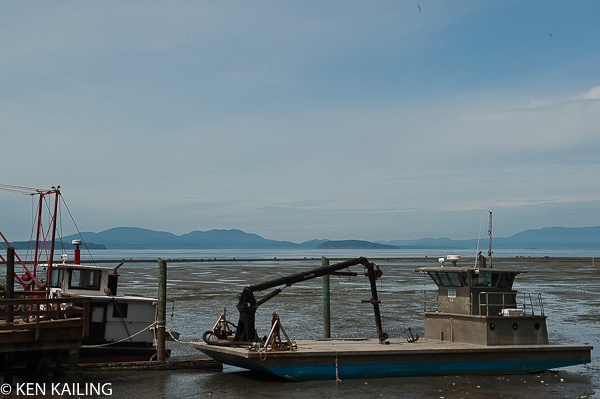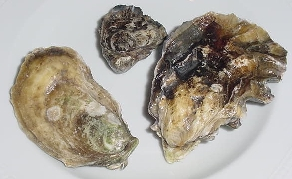“Shellfish – a delicious, healthy, sustainable resource that enriches our environment, our culture, and our economy.”
Pacific Coast Shellfish Growers Association
By the time the first settlers reached the small spit of land that was ultimately to become part of Seattle Washington in 1850, the Olympia oyster population on the Pacific coast was already beginning to be over harvested. And in the early 1900s, poor water quality in Puget Sound threatened to finish it off.
More than a century later, Washington, Oregon, and Alaska have a significant hatchery-based oyster industry and are now the major producers of the Pacific oyster in the U.S. The non-native Pacific oyster, first imported in the early 20th century, is the most important commercial oyster species in the region.

Oysters’ “Environmental Services”
While discriminating diners consider a platter full of oysters on the half shell a treat, most don’t realize those bivalves provided a necessary environmental service by filtering and cleaning the water in which they lived.
Shellfish, and oysters in particular, filter water very effectively – filtering 20 to 30 quarts of water an hour – and can quickly clean muddy or polluted water. By the very act of feeding, shellfish filter phytoplankton (nutrients including nitrogen and phosphorous) out of the water, cleaning and clarifying it.
 Shellfish growers carefully monitor the water quality in Puget Sound. Heavy rain, agricultural runoff, or oil spills will all trigger closure of oyster beds. Because the water is filtered through the oyster’s body, any toxins or pollutants can affect the meat. Daily testing of water quality monitors the beds and potential contamination is caught at the earliest possible moment thus preventing the sale of inedible oysters.
Shellfish growers carefully monitor the water quality in Puget Sound. Heavy rain, agricultural runoff, or oil spills will all trigger closure of oyster beds. Because the water is filtered through the oyster’s body, any toxins or pollutants can affect the meat. Daily testing of water quality monitors the beds and potential contamination is caught at the earliest possible moment thus preventing the sale of inedible oysters.
No shore land, even that in Puget Sound, is free from the risk of spills. While big spills from oil tankers are a concern for regional shellfish farmers, it’s the ongoing day-to-day drainage of oil, gasoline, and other chemicals that come into the Sound that cause a “slow motion” oil spill.
Run off from freeways, drainage from storm drains, oil leaks from cars; all mean that a lot of oil and other chemicals are getting into the water. It’s just very dilute and comes from many, many different sources.
Polluted Water Closes Oyster Beds
While oil spills remind the public that water quality is at risk, it’s the ongoing day-to-day drainage of fecal matter – animal and human waste – that is a bigger problem today. Called “nonpoint pollution” because it comes from many sources rather than identifiable “points,” pollutants come from farmland or storm water runoff, leaking septic tanks, and even pet waste.
In the 1990s a major effort focused on cleaning up Samish Bay and runoff problems were greatly reduced. Unfortunately the water coming down the Samish River continued to bring in pollutants.
In the past, state-level water quality testing was done on a schedule, not triggered by weather events, and in 2008 this “ambient” water testing overlapped with a period of rainstorms. It was then that the increased water flow brought in more fecal matter and tests identified it as a problem. The Washington Health Department began testing the water after every heavy rainfall and closed the shellfish beds more often.
Throughout 2009 and 2010, emergency closure of the beds happened frequently. In 2011 more than 4000 acres in Samish Bay were reclassified and downgraded in order to bring about more careful management. Shellfish farming is a $100 million business in Washington and the state’s goal to increase the area of harvestable shellfish beds to 10,800 acres by 2020 was set back considerably by the downgrade.
Samish Bay drains an area that is primarily rural, where many commercial farms have been broken up into 5-acre “farmettes.” Non-commercial livestock such as buffalo, alpaca, llamas, goats, horses, or a few cattle are often the animals of choice on small acreage. Unfortunately, the owners of these smaller holdings generally don’t have the farming and soil conservation skills needed to know how to manage animal waste and prevent runoff.
The water quality issues have highlighted these smaller holdings as a serious problem. While large dairy operations and livestock CAFOs – confined animal feeding operations (there is only one in the Samish watershed) – must operate under strict animal waste management regulations, these farmettes with a small number of animals more or less “fly under the radar.”
Climate Change and the Future of Puget Sound’s Shellfish
Combine agriculture runoff and rising carbon dioxide levels in air and water and you have a prescription for shellfish collapse. In Hood Canal, a Puget Sound estuary, water pH has become surprisingly acidic – a condition which damages the shells of marine mollusks like oysters, clams, and mussels.
Water in the open ocean average a pH of 8.1 on a 14-point scale where battery acid tests at 0, pure water at 7, and drain cleaner at 14. Hood Canal water measured 7.4 in the summer of 2008. Nutrient runoff and the upwelling of more acidic deep water affects the shell development of baby oysters – “oyster seed.”
Not only is climate change affecting the acidity of water and the viability of oyster seed, the projected rise in ocean temperatures in the coming decades will likely bring more toxic algal blooms and the increased risk of diarrhetic shellfish poisoning (DSP). DSP comes from eating shellfish contaminated by a toxin produced by a type of algae called Dinophysis.
In recent years, toxic algal blooms have been more potent and lasted longer than historic blooms. The more runoff you have, the more nutrients washed into the waterways, and with more nutrients come more algae and higher chances that the algae may be toxic. Add to that the larger issue of climate change and you have warmer water and the potential for increased prevalence and toxicity of Dinophysis.
For those future discriminating diners, a platter full of oysters will much more expensive. Not only will baby oysters have to be treated with tender loving care to bring them to maturity, they may never make it to market if testing and monitoring identifies the presence of Dinophysis toxins.
When that day comes, Washington will see the end of a centuries-old shellfish culture.

